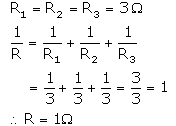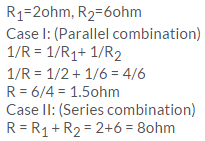Solutions of Electricity (Page No- 37) - Physics By Lakhmir Singh, Class 10 | Extra Documents, Videos & Tests for Class 10 PDF Download
Lakhmir Singh Physics Class 10 Solutions Page No:37
Question 1:
Give the law of combination of resistances in series.
Solution :
According to the law of combination of resistances in series, the combined resistance of any number of resistances connected in series is equal to the sum of the individual resistances.
Question 2:
If five resistances, each of value 0.2 ohm, are connected in series, what will be the resultant resistance ?
Solution :
As per the law of combination of resistances in series,
R=R1+ R2+ R3+ R4+ R5
R=0.2+0.2+0.2+0.2+0.2=1ohm.
Question 3:
State the law of combination of resistances in parallel.
Solution :
According to the law of combination of resistance in parallel, the reciprocal of the combined resistance of a number of resistances connected in parallel is equal to the sum of the reciprocals of all the individual resistances.
Question 4:
If 3 resistances of 3 ohm each are connected in parallel, what will be their total resistance ?
Solution :

Question 5:
How should the two resistances of 2 ohms each be connencted so as to produce an equivalent resistance of 1 ohm ?
Solution :
Since the resultant resistance is less than the individual resistances, so the resistances should be connected in parallel.
Question 6:
Two resistances X and Y are connected turn by turn : (i) in parallel, and (ii) in series. In which case the resultant resistance will be less than either of the individual resistances ?
Solution :
In case of parallel combination, the resultant resistance will be less than either of the individual resistances.
Question 7:
What possible values of resultant resistance one can get by combining two resistances, one of value 2 ohm and the other 6 ohm ?
Solution :

|
5 videos|292 docs|59 tests
|
FAQs on Solutions of Electricity (Page No- 37) - Physics By Lakhmir Singh, Class 10 - Extra Documents, Videos & Tests for Class 10
| 1. What is electricity? |  |
| 2. How is electricity generated? |  |
| 3. What is the role of conductors in electricity? |  |
| 4. How does electricity reach our homes? |  |
| 5. What are the safety precautions to be taken while dealing with electricity? |  |























